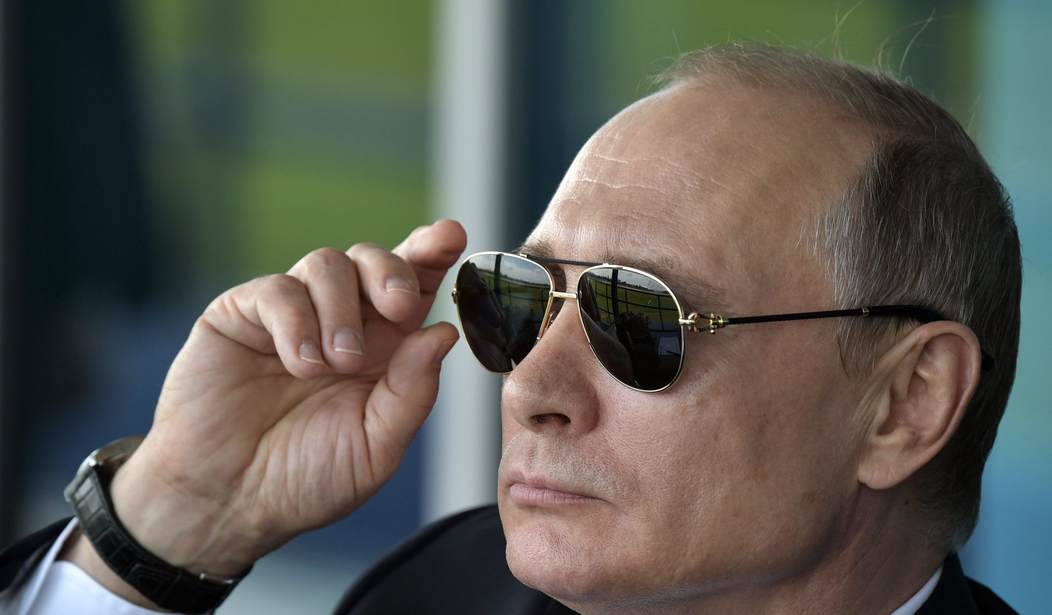You might remember Vladimir Putin’s speech last month, in which he revealed five “new” nuclear weapons systems. They weren’t really new, because as Norman Friedman notes in a new article, “the Sarmat ballistic missile, the Avangard hypersonic maneuvering reentry vehicle, the Kinzhal air-launched hypersonic cruise missile, the Status-6 nuclear-powered autonomous underwater vehicle, and a nuclear-powered cruise missile,” are all derived from previous Cold War-era systems. But it was a helluva speech, filled with sound and fury… but aimed at whom, exactly?
That’s where Friedman’s new piece for the U.S. Naval Institute gets really interesting, because he posits that Putin’s bluster was not, despite all appearances, aimed at the West. Friedman believes that Putin’s real audience sits at the headquarters of the Communist Party of China in Beijing. Friedman reminds us that “Chinese maps still show one of the results of the ‘unequal treaties’ between the Qing Dynasty and foreign powers — Russia’s possession of large swaths of Chinese Siberia, where many ethnic Chinese live today.” And then there’s the “intense nationalism” which the CPC has nurtured, especially in the last two decades as the country has grown rich.
The view from the Kremlin not only includes Chinese revanchism, but also that “the Russian Army is thinly manned while the Chinese have a seemingly bottomless pool of manpower coupled with increasingly sophisticated weaponry.”
From there, things look even more desperate from the Russian point of view. Anyone who paid attention to late Cold War history must remember how deeply rattled the Kremlin was by Ronald Reagan’s Strategic Defense Initiative. Desperately poor in so many ways, the Soviets simply could not afford to keep up with America’s financial and technological might. They had no greater fear than the U.S. developing a missile shield strong enough for us to hide behind while launching a first strike against them.
And now history might be repeating itself — not between Moscow and Washington, but between Moscow and Beijing. Friedman notes:
The Chinese have been testing antiballistic-missile interceptors since at least 2010, with the most recent test in February 2018. Russia may have interpreted the February test as a threat to its most important military asset—nuclear weapons. At some point in the near future, China will have a national strategic defense system. But China will not be able to defeat a mass nuclear attack any more than Russia or the United States will. On the other hand, the Chinese Communist Party may be more willing than the United States to sacrifice a great deal if it can preserve its national leadership in Beijing. Chinese rulers might imagine that they can buy enough interceptors to achieve that.
Friedman also says that “Putin probably prefers deterrence over attacking China,” and there’s no reason to doubt that. We’ve never had a direct shooting war between heavily-armed nuclear powers, and hopefully we never will. Whatever those two countries’ difference are, a peaceful resolution would be in everyone’s interest, rather than, say, Russia launching its new nuclear-powered cruise missiles, “cruising over a wide area, spewing radioactive exhaust on its way to detonation” over Beijing and China’s vital coastal cities.
It’s been my view since the end of the Cold War that Russia and the United States ought to be perfect partners. One writer (I wish I could remember who, but there’s no reference to this online) proposed a global “Pax Americana-Sovieticus” in which the two former enemies enforced a global order. This was during the brief interlude between the Soviet Union’s historic U.N. vote in favor of the first Gulf War, and the final dissolution of the U.S.S.R. just a few months later. And so of course nothing came of it.
And then there was NATO’s ill-considered expansion right up to the borders of the old Soviet Union — and beyond it, nearly to the gates of St. Petersburg, in the case of the Baltic States. That fed into Russia’s age-old paranoia about Western intentions, which Putin has ruthlessly exploited to further his power.
But unlike China, the U.S. has no territorial ambitions in Siberia. We have no history of border clashes or “unequal treaties,” or any of the other long list of grievances shared between the Russians and Chinese. And as established powers, both Russia and the U.S. share a common interest in containing China’s rise to Great Power status.
It would take some creative diplomacy on our part, and an unlikely willingness on Putin’s part to give up on centuries of anti-West paranoia. But if Richard Nixon could pry China out of Russia’s orbit in the early 1970s, perhaps this Administration could pull Russia out of China’s orbit today — especially since Russia shows five nuclear-powered signs of wanting out already.









Join the conversation as a VIP Member